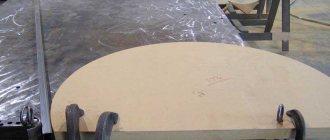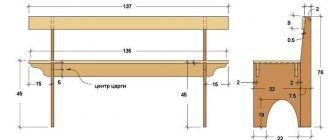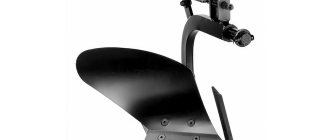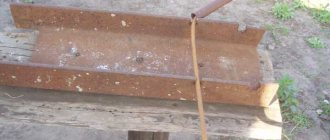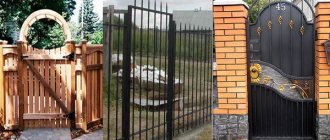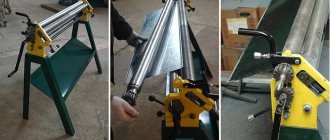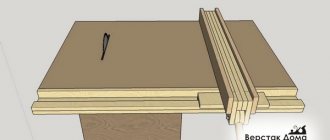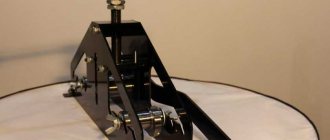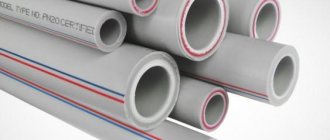How to build a hydraulic pipe bender
The design of a hydraulic pipe bender with your own hands is presented in the video below.
Building a tool of this type will not be difficult if you have two 0.5 meter channels at your disposal. The base of such a device included the following elements:
- hydraulic cylinder;
- stops;
- supercharger.
In addition, you should also highlight:
- A jack that can withstand loads of up to 5 tons.
- There are 2-3 rollers.
- Channel - 3-4 mm.
- Thick plates.
The principle of using such a tool is that you need to install a profiled pipe into the shoe. Use a jack to set the required bending radius. When the jack is inflated, the rod rises, pressing on the roller. After establishing the bending angle, the pipe can be removed. This type of bending device is relevant when it is necessary to bend a pipe in one place, for example, when installing a heating system.
What types of pipe benders are there?
Let's start with the simplest thing, with classification. And according to it, all existing pipe benders are divided into two large groups.
- The first includes inventory that applies to the entire product. This is used to roll arches for greenhouses, canopies, and other things. It can work with both profile and round pipes.
- Another list includes a tool designed for point bending. It allows you to change the vector of the pipe up to one hundred and eighty degrees. Most often used in the construction of plumbing and heating systems, as well as in production. Due to the huge variety of models available on the market, this is what we will consider first.
Design and principle of operation of an electric pipe bender
The main load when operating a pipe bender with an electric drive falls on the powerful engine. It is he who transfers the rotational load to the bending element. Various attachments are put on the rotor, the shape of which depends on the expected result.
In addition, the structure of the pipe bender includes the following parts:
- frame;
- clamping devices;
- fastenings;
- control panel.
If it's a cheaper option for regular users, it will usually have setup buttons and a control panel. On industrial machines of this type, displays are installed, with the help of which settings are made.
The main functions of the clamps are:
- reliable fixation of the workpiece;
- protecting the employee from possible injuries.
Fasteners also serve to hold the bent element in the position required for operation.
How to make a pipe bender with your own hands instructions
If you have an example or diagram of a pipe bender, then making the machine yourself will not be difficult. You must adhere to the appropriate sequence of actions. To make a pipe bender for a profile pipe, the following manipulations are performed:
- On the shaft you need to place gears, as well as bearings and rings. The production of shafts is entrusted to an experienced turner. If you plan to create all the parts yourself, then you will need three shafts, two of which are distributed on the lower base (a channel serves), and the third is suspended on springs.
- The corresponding holes are drilled in the rings, which are needed in order to cut the thread. This thread is needed to attach gears to the shafts.
- The shelf for securing the third roller is also made from a channel.
- All elements are distributed on the frame and combined by welding or bolted connections.
- The first step is to install the frame on which the corresponding structural elements are distributed.
- The shelf is welded perpendicularly to the base.
- A handle is attached to one of the shafts.
- Finally, to adjust the bending radius of the profile pipes, you need to install a hydraulic jack on the top shelf.
If you make a tool according to a template, then there will be no difficulties
To clarify some points, you should pay attention to the following factors:
- The pressure shaft located on the shelf must be additionally secured to it. It is also secured with dowels.
- The pressure roller is made by performing the following manipulations: a shaft is fixed to the shelf, as well as springs that are attached to pre-installed nuts. After making the shelf, it can be welded to the frame of the main device.
- To tension the chain, you need to use a magnetic corner. It will serve as a holder.
- The sprockets are fixed with dowels made from Grover.
- The drive handle is constructed from a steel tube.
- The jack is placed on a hanging shelf.
The design of the simplest homemade unit for bending profiled pipes is presented in the video below.
How to make a pipe bender for a profile pipe yourself?
When working with profile pipes, the above option cannot be used. It’s simply not possible to place rectangular or square items in hooks. Therefore, to work with such rolled metal, you need to assemble a special roller pipe bender. By familiarizing yourself with the drawings and rules for assembling the machine, you can make a truly convenient and practical machine. To make it you will need: a metal frame made of a steel profile (made independently), a jack, 3 shafts, rollers. The following instructions will tell you how to make a pipe bender with your own hands:
1. Make a metal frame from steel profiles. You can additionally weld fasteners to the bottom part, with which it will be fixed to the tabletop. Between the bottom (support) and the top part (the shafts will be located on it) there are 2 vertical supports: in the center or on one of the sides. On the other hand, without support, the part of the profile with the roller will rise, so it must be attached to the rest of the structure with bolts. A jack will be used to lift this part.
2. Shafts are welded to the finished frame with a lifting movable part. The pair is located on the left and right, closer to the edge. You need to prepare supports for the third pressure shaft. It must be welded to them.
3. A handle made of steel pipe is welded to the pressure shaft. It will help you manually bend the pipe.
4. To prevent the bent pipe from moving, it is necessary to weld a pair of vertical shafts and rollers between the side shafts and the pressure shaft. Passing between the thin shaft and the roller, the pipe will not move significantly to the side, which will ensure accurate work.
5. Finally, a jack is mounted under the movable part of the profile with a side roller (you can use a hydraulic bottle jack or a regular rack jack). If necessary, it can be fixed to the frame.
Before starting work, be sure to study the parameters of the jack used and prepare a frame in accordance with its dimensions. It is recommended that you first draw diagrams with a detailed description of the specified parts: this will allow you to avoid errors when assembling the machine. The metal frame and auxiliary elements must be welded with high quality. Otherwise, with significant force, they may simply become detached, which will lead to the need to re-weld the machine. It is also worth studying the attached photo and video materials, which allow you to familiarize yourself with the features of the manufacture and use of homemade pipe benders in everyday life.
Making a simple template-type pipe bender
A simple rolling pipe bending machine can even be made from wood. Naturally, this will be a manual pipe bender, the design of which may not even include a pressure roller if it is used for thin-walled products. The template for such a device is made from a wooden board, the thickness of which should be such that it exceeds the diameter of the pipe itself.
Wooden template for a simple manual pipe bender
For ease of work, it makes sense to consider profiling the template from its end in order to avoid the pipe jumping off during bending. For these purposes, you can fold two boards, first sawing one edge at a time, thus creating a kind of gutter. A pre-drawn drawing will help avoid mistakes.
When using such a pipe bender, the template is attached to a reliable base, and a stop is attached to the left side of it (for right-handers). The pipe that needs to be bent to the required radius is placed between the template and the stop and carefully bent, making sure that it does not jump off the template.
Collapsible hook template
With the help of such a pipe bender, made from scrap materials, you can bend along a large bend radius. You can avoid making a wooden template and simplify the device by replacing it with metal hooks fixed to the base, located in a circle with the required bend radius. This device is convenient in that the dimensions of the bend can be changed at any time by placing the stop hooks around a circle with a different radius.
Armed with a manual winch, you can significantly expand the range of work performed due to a noticeable increase in traction force for bending pipes.
The winch will help expand the functionality of the simplest manual pipe bender
How to make different types of pipe benders
The principle of operation of pipe benders is different - you can influence a section of pipe in different ways. For example, a spring-type device will help deform polymer pipes due to pressure. Segmental devices will stretch them, giving them curvature.
The method of making a template pipe bender is accessible even to a beginner. To do this, you need to accurately draw a part of a circle of the required diameter (or other type of curvature). This hemisphere or other curve is drawn on a wooden blank, as in the photo of a homemade template-type pipe bender.
The resulting part must be fixed on a stable base along the plane (wall, table).
After the template stop is ready, you need to figure out how to use a pipe bender of this type. This is clear from the drawing - the pipe is secured between the template and the thrust beam.
By exposing the opposite end to a heated aluminum or thin steel billet, the desired bend is obtained. If it is necessary to obtain segments of different curvature, several suitable templates are made.
Types of pipe bending mechanisms
Devices that allow you to bend a steel pipe to a certain radius are divided according to the following characteristics:
- Mobility. Pipe benders can be stationary or portable.
- Type of drive. Depending on this feature, manual, electric, hydraulic and electro-hydraulic devices are distinguished.
- Method of influence. The tubular product is bent under the influence of rolling, winding, rolling and rod.
Before you make a pipe bender at home, you need to understand how the device affects the workpiece and become familiar with each process separately.
Run-in
This method involves performing the following actions: one end of the tubular product is pressed against a stationary template and the pipe is rolled around it using pressure rollers.
Winding
This type of device has a movable template. A pipe is directly wound onto it, which passes between the template and a special stop located at the beginning of the bend.
Crossbow type pipe bender
This device is equipped with two fixed rollers and a template mounted on a movable rod. When the rod presses in the middle of a certain section, the pipe bends.
Rolling
The design is made on the basis of two support rollers and one central roller. This three-roller mechanism helps to obtain the required radius when bending as a result of pressing the central roller on the pipe, the position of which determines the bending radius. This makes it possible to call this type of pipe bender universal, since all other types bend the pipe according to a specific pattern.
A pipe bender operating on the winding principle is quite difficult to make at home, so industrial enterprises produce such mechanisms. When using a crossbow pipe bender, it is worth remembering that the impact of the rod on the pipe product can cause the material to rupture. Consequently, these mechanisms are not suitable for bending products with thinner walls. The rolling device has no significant disadvantages; it is used in the factory production of bends.
The design of a machine for bending home-made tubular products can be varied. Select the desired device according to the required bending radius
In addition, it is worth studying the recommendations for choosing a device, and also taking into account the main parameters of the pipes used: diametrical cross-section and wall thickness.
Device of manual edge benders
Edge benders, although somewhat similar in appearance to sheet benders, have a fundamental difference - the height of the shelf usually does not exceed 5...20% of their length. A lower value corresponds to flanging the inner edge. When bending there is no such limitation, which predetermines noticeable design changes in the compared devices.
The first of them concerns the length of the flanging working area - for manual edge benders it can be small, since the height of the bead and the radius of curvature do not change. Accordingly, portable manual edge benders are produced, moving which along a pre-marked flanging line, we obtain the required profile.
If the edge formation zone is large, the process should be performed simultaneously. In such cases, an edge bender is more similar to a sheet bender, differing, in fact, only in the way the workpiece is pressed.
Let's consider the first version of the device. Portable manual edge bender for gradual bead shaping includes:
- Two handles, and one of them or both can be movable.
- Lever reinforcement system to create the required flanging force.
- Working jaws with a profile that matches the dimensions of the edge. Typically, the manufacturer equips a manual edge bender with a set of several jaws and the most commonly found in practice edge height and radius of curvature during the transition from the edge to the main plane.
- Adjustable travel stop: most often this is a removable slotted screw equipped with a thrust thread.
For ease of use, the handles are rubberized, which prevents the operator’s hand from slipping while applying force.
The second version of a portable manual edge bender is a roller bender, where the sliding friction of the jaws on the workpiece is replaced by rolling friction when the working rollers rotate. In this case, the shaping force is significantly reduced, but the tool turns out to be less universal, since there is only one pair of rollers, and it is not possible to change the edge formation parameters except by replacing a pair of rollers, which is quite labor-intensive. In addition, roller edge benders in most cases fail to perform internal flanging along small radii.
The main disadvantage of manual portable edge benders is their low accuracy: when moving the tool along the uneven line of the future edge, an error gradually accumulates, which at the end of the operation can reach a millimeter or more. This is unacceptable during auto body repair, so the quality of bead formation is determined only by the experience of the performer.
Do-it-yourself manual edge bender
Let us dwell on the option of designing and manufacturing a manual edge bender with simultaneous production of an internal or external contour along the entire length of a pre-marked workpiece. The general view of the device is shown in the figure. Such a manual edge bender can be used not only in car repair shops, but also in roofing work, the manufacture of tin ventilation ducts and other spatial products made of sheet metal.
The dimensions of a homemade manual edge bender are determined depending on the largest dimensions of the workpiece for which flanging is performed. For example, for large products, it is more expedient to build a table from wood or multi-layer plywood, on which to mount the edge bender; in other cases, the structure is welded from channels and sheet metal.
The design of the manual edge bender is designed for sequential execution of two transitions:
- clamping the workpiece using a clamp and lower clamp;
- flanging along a given contour by turning the handle with the punch located on it.
It is usually recommended to make a welded version of such an assembly, but this is impractical: the parameters of the flanging curve may change, and it is no longer possible to change the punch. Therefore, taking into account the small forces arising during deformation, it is better to produce a collapsible punch, which is a collection of individual modules, characterized by their radius of curvature and edge height.
The fastening of such punches to the beam is carried out using bolts (of course, all seats must be designed and made with the highest possible accuracy).
The edge formation itself is performed after the workpiece is securely fixed between the upper and lower clamps (the latter ensures smooth clamping due to the spring mounted on the rod in the upper plane). The combination of the two halves of the flanging die is carried out by moving the support bracket along the mating surface of the stops, which act as guide elements of the manual edge bender.
By changing the configuration of the punch modules, you can perform flanging not only at a straight line, but also at any other angle - up to 110...120º (to do this, you just need to provide a small bevel on the limiter, which is visible in the figure).
Pipe benders with pressure roller
A more complex design is a manual pipe bender, which uses a pressure roller. To make such a device, you can use both wood and metal.
For pipes made of soft materials (for example, copper), wood rollers are the best option, since they do not cause metal deformation. It’s not at all difficult to make such videos at home if you use photos or drawings of similar devices, which are posted in large numbers on the Internet. The manufacturing material can be thick boards or several layers of plywood.
Drawing of a pipe bender with a pressure roller
A homemade pipe bender of a similar design, which is based on rollers - movable (pressing) and stationary - allows you to bend round pipes that even have a significant diameter.
In order to understand that such a device is simple in design and use, just look at its photo or drawing. Depending on what loads are expected for a pipe bender of this type, the base for it is made of metal or durable plywood. The U-shaped holder on which the central and pressure rollers will be placed is made of metal.
Relative to the axis of the central roller, securely fixed to the base, such a holder must be able to rotate. On the reverse side of the central roller, a handle is attached to the holder, which is a lever, so the force created directly depends on its length. This lever pipe bender allows you to perform operations with different bending radii of pipes.
Many people wonder whether it is possible to make a winding-type pipe bender with your own hands. Naturally, it is first advisable to study a drawing or photo of such a device, which does not have a stop on the base. The design of this type of pipe bender is based on two pulleys, a frame with a lever and a pressure roller, and a reliable base. Bending using such a device is carried out due to the fact that the pipe, placed in the groove of a stationary pulley and clamped with a clamp, is wrapped around a template using a lever and a movable roller.
Pipe bender for soft pipes with two different bend radii
For small and soft products (aluminum or copper), a homemade pipe bender is suitable, allowing bending with two different radii. Photos of such a device are easy to find on the Internet. This pipe bender uses one pressure roller and the template is made with two radii at the same time on one plate. Naturally, for each bending option, the pipe bender handle must be reinstalled, for which two holes are provided on its base.
Crossbow-type hand pipe benders
These are the simplest pipe benders. Typically used by plumbers for bending thin metal-plastic pipes or thin-walled pipes made of copper, brass and aluminum. Pipe diameters are usually from 5mm to 32mm. The design of such pipe benders is quite simple. The force on the handle is created by the force of pressing the lever. The tighter the handle is pressed, the larger the angle we get at the exit. In general, the effort of one man's hand is enough to bend the pipe at an angle of 90 degrees. All that remains is to choose a template (punch) suitable for the diameter of your pipe.
VIDEO:
How to assemble ET yourself
If you wish, you can assemble an electric pipe bender with your own hands; you just need to perform a series of sequential steps.
At the initial stage, it is worth deciding what frame the device will have. This structure can be assembled from rectangular profile pipes with a wall thickness of 3 mm.
At the end of the profile, 3 cm from the end, make a hole with a cross-section equal to the dimensions of the axis.
The next step in assembling an electric pipe bender with your own hands includes several steps:
- A control lever with a movable wheel driving the belt is mounted on the frame.
- Install a stationary wheel.
- Secure the falling shaft. A pulley with a belt drive from the engine is placed at the end of the shaft.
- At the second end of the frame there is a star for the drive gear.
- The second shaft is attached last.
Next, you can begin trimming the profile. The degree of trimming of this part will depend on the desired bending angle, taking into account a margin of 5 cm. Any excess can be cut off with a hacksaw.
The axle on which the wheel and lever will be installed is easy to make yourself:
- you will need two steel plates with a width equal to the diameter of the axle and a thickness of 5 mm;
- By putting the steel pipe and these two plates together, you need to weld the structure.
Now you can begin assembling the entire mechanism.
This can be done in several steps:
- The finished frame from the profile must be securely fixed in a vice.
- Now we install the axle into the holes made in advance.
- We connect the axle with the handle and the wheel.
- Tighten the wheel securely with the bolt.
- At the end we mount the clamp with a pin.
Since the actuation of the pipe bender, which was assembled by hand, was intended to be connected to the electrical network, the last thing that needs to be done is to connect the electric drive to the machine. This device will cause the shaft to rotate.
Thus, we can say that electric pipe benders are distinguished by their efficiency and versatility. In addition, the ability to quickly complete work makes them indispensable in industrial enterprises and when performing work at a professional level.
Making an electromechanical pipe bender
We decided to tell you how to make an electromechanical model of a pipe bender. Such equipment can cope with any amount of work without the need to apply physical force.
For study, we present two versions of instructions on how to make a pipe bending machine for round pipes with your own hands. If you have any questions after reading the text manual, we recommend watching the video materials as well.
How to make a pipe bender without welding and turning. Dimensions, drawings, nuances of The pipe bender
The device consists of three working elements - one pressure roller and two support rollers, which is why it is also called a three-shaft rolling machine. This is one of the most complex bending mechanisms that you can assemble with your own hands, but we decided to start with it. If we succeed, then it will not be difficult for us to make simpler types of pipe benders.
So, we will make the device from: 204 bearings, anti-roll bar from a VAZ car, nuts, studs, pipe scraps (20 by 40 with a thickness of 2 mm, 15 by 15 by 1.5 mm; 80 - 80 - 5 mm), metal sheet 3 mm thick.
To assemble the electric bending machine, we used the following drawings.
Diagram of a rolling machine Shaft diagram Drawing of a fork Supports for bearings Drawing of a jaw Diagram of a clamping screw
Let's get to work, step-by-step detailed instructions are as follows:
- We prepare the frame - for this you will need two pieces of reinforcement or profile of the same size, on the top wall of which we make 4 holes for our studs.
Parts for the frame
- We cut out two side walls of the structure from a metal sheet, make holes in the blanks for attaching them to the frame and installing the rollers, as well as a large window for the movable roller. Holes should be made in two workpieces at once so that they coincide.
Cutting out the sides
- We take the cross-section stabilizer from the Zhiguli, grind it under head 19, this will allow you to rotate the shaft with a screwdriver. A bearing with a diameter of 20 mm will be placed on it.
Making grooves on the stabilizer Putting on the bearing
- We begin to manufacture a clamping mechanism from a screw and a piece of channel, the size of which should be slightly smaller than the distance between the side walls of the structure so that the workpiece moves freely in it. We make a hole in the channel equal to the size of the screw, into which we weld a nut. Then we screw in the screw and secure it with a nut from below. We drill a hole in the top of the screw and insert a pin into it, which will serve as a handle.
Weld the nut and insert the screw
- We put two bearings on the shaft and secure them with washers. The workpiece is installed on the channel, in which we previously made holes for the pressure screw and side holes for fastening.
Assembling the pressure shaft
Let's start assembling the device:
- insert the studs into the holes of one side wall and secure them with nuts;
- the middle pins are our input and output rollers, they are stacked, the size depends on the configuration with bearings for various tasks;
Insert roller pins
- We put washers on the lower studs, and then install two blanks from the profile, which will serve as the base of our machine;
Installing a profile base
- We place the pressure shaft in the middle of the structure, pushing the screw into the hole, it should be located exactly in the center between the rollers, and between the screw and the cheeks we install gaskets made of a metal plate;
Place the pressure shaft
- We fasten the clamping screw to the shaft channel with a nut;
Fasten the clamping screw
- cover the structure with the second sidewall and tighten the nuts.
We dress the wall
If you weld a handle to the shaft, you get a mechanical device that will work from your efforts.
The machine is ready, all that remains is to put the head on the sharpened side of the shaft, and then use a screwdriver to operate the device. This is a universal ring bending machine, using it you can bend not only round, but also profile pipes; you just need to change the nozzles on the rollers.
Types of electric pipe benders
The operating mechanism of electric pipe benders may differ. Let's look at some types of such products.
Winding machines
. In this case, a special shaft is installed on the device, which is rolled along a pipe fixed in the machine, thereby creating a bend of the desired configuration.
Roll-in pipe benders
. Such devices have paired rollers. The mechanism of action of such equipment is called mandrelless. The peculiarity of such pipe benders is the limited bending angle of the products, which coincides with the diameter of the fixed shaft. Typically, equipment of this type comes with a set of various rollers designed to increase the capabilities of the device.
Products with a rolling mechanism
. These pipe benders have three rhythmically operating rollers. Equipment of this type is often used in the manufacture of decorative jewelry from profile pipes.
With squeezing principle of action
. This is the most common type of product, shaped like a crossbow. In this case, the pipe is fixed on both sides, and the bending is done by extrusion. The bend configuration depends on the type of nozzle. However, working on such equipment takes a lot of time.
Stationary pipe benders
For stationary equipment, a separate space is required, since they are large in weight and size. These ET models have a strong, large frame that supports a fairly powerful engine.
Such devices can work with pipe products of all types and sizes. In particular, they can process profiled steel pipes with thin walls, products with a large cross-section and thick walls, used in high-pressure water mains.
Compared to stationary devices, handheld ETs have more limited capabilities, although they can still be very useful for their purposes.
Manual lever pipe bender
If you do not need such a complex device, but only need to bend a small round steel pipe, then you can make a simple lever mechanism. It is designed for bending pipes with thin walls.
Watch the video for manufacturing instructions.
PIPE BENDER FOR ROUND PIPE
We also decided to try to assemble this pipe bender with our own hands. We will need: a shaft with a round profile, a pressure roller, a metal sheet of 8 for the frame, studs, nuts.
Someone can make this device by eye, but it is better to prepare a drawing of a pipe bender or find a suitable option on the Internet. We decided to work according to the drawing.
Drawing of a lever pipe bender
Drawing of the lever fork
Let's start making:
- We make blanks for the fork. The size of the fork depends on the distance between the wheels, or more precisely on the seat of the pipe, it should be equal to its diameter plus 1–2 mm. Cut it out of a metal sheet and grind it:
- frame and cover for the shaft;
- support for the frame and a small stand for the lid;
- two rectangular plates, along the edges of which we make holes for the studs.
Cutting the blanks
- We make holes in the cover and frame for attaching the shaft.
Making holes
Finished blanks
- We fix the stop in a vice, weld the frame to its middle, and the stand for the lid to the top, grind the seams.
We weld the parts
- We thread the pin into the hole of the station, put on the shaft and cover it with a lid made of metal sheet. We tighten the nuts on both sides.
Installing the shaft
- We fasten the cover to the stand with bolts.
Fastening the lid
- We screw two rectangular blanks onto the nuts on both sides.
We assemble rectangular blanks
- On top, between these plates, we place a roller, which we secure with a pin and nuts.
Installing the roller
- We weld two plates of the fork, placing a channel blank between them.
We weld the fork
- We screw the handle from a piece of metal profile.
Connecting the handle
Well, the lever pipe bender is ready, it turns out that almost any home craftsman can make it himself.
Stationary pipe bender step by step instructions
If you plan to make your own greenhouse from steel pipes, then you will need to acquire not just an ordinary pipe bender, but a reliable product. After all, with this approach you will need to bend more than a dozen profile pipes. To make the greenhouse design neat and beautiful, you need to use a stationary pipe bender.
Before you start making a greenhouse, you need to make sure that you have the appropriate tool for bending profile products. The following elements will be needed to construct a stationary pipe bender:
- rod at 25;
- 6 bearings;
- channel.
You will also need a welding machine, which will be used to connect all the components. Step-by-step instructions for making a stationary pipe bender are as follows:
- Bearings are welded to the base (channel), which are connected to each other by a shaft in the form of a steel pipe of the appropriate diameter.
- To prevent the shaft from being located too close to the base, the bearings should be welded onto 5 cm pieces of rectangular pipe.
- In order to deliberately produce a unit with which the bending radius could be adjusted, the base must be made of two channels connected to each other by curtains, as can be seen in the photo above.
- Two shafts with bearings are located at the same height, and the third (central) is welded using a rectangular tube 15-20 cm higher.
- An additional tube needs to be welded to the upper shaft, to which the handle will be attached. This shaft will be driven by muscular force.
- The handle is welded to the upper shaft, after which the resulting product can be checked for functionality.
When installing a profile tube of any size, you should adjust the radius of the final bend. This can be done using a jack located under the base on which one of the shafts is fixed. Having adjusted the required bending radius, the handle rotates. The result is high-quality curved tubes. The advantage of a pipe bender is the ability to bend materials of any size and diameter.
Among the disadvantages, we can only note the possibility of operation in one place
It is important to understand that such a device can be used for any need. To manufacture such a device, an investment of no more than 500 rubles will be required.
You only need to buy 6 bearings, and all the other elements can be found in every craftsman’s household.
Pipe bending equipment
The question of how to bend a pipe without a pipe bender will not cause difficulties if you use the simplest devices to perform this operation. You can perform cold bending of pipes using the following devices.
- In cases where it is necessary to bend a soft (aluminum) or steel pipe with a profile height of no more than 10 mm, a horizontal plate with holes is used into which stops - metal pins - are inserted. Using these pins, products are bent according to the required parameters. This method has two serious drawbacks: low bending accuracy, and also the fact that when using it it is necessary to exert significant physical effort.
- It is better to bend products with a profile height of 25 mm using roller devices. The pipe is securely fixed in a vice, and force is applied to the part that needs to be bent using a special roller. This device allows you to get a better bend, but also requires physical effort.
The option, as they say, is a quick one. The long lever of this extremely simple device allows you to cope with fairly thick pipes
To form a bend with a large radius of curvature on steel or aluminum professional pipes, stationary round templates are used, on which special clamps are mounted to fix the product. Using such a device, the pipe is also bent manually, placing it with force into the groove of the template, the shape of which exactly corresponds to the required bending radius.
Plywood and metal staples are all you need to make a bending template
Bending plate
To effectively bend steel or aluminum pipes at home, you can make an upgraded bending plate using the following guidelines.
- The role of such a plate is played by a panel cut from thick sheet metal.
- The panel made in this way is welded to a stand, which is installed on a special pedestal.
- Two holes are drilled in the panel, which are necessary for installing bolts that serve as stops for the profile pipe.
- A special attachment is installed on one of the stop bolts, with the help of which the bending radius is adjusted.
- To ensure the alignment of the pipe sections adjacent to the bend, a metal plate is placed above the workpiece, secured with bolts.
Mandrel bending
For bending profile pipe products at home, the wall height of which does not exceed 25 mm, you can make a special mandrel. For these purposes, it is better to use a large workbench, on the surface of which there will be enough space for such a device. To select the optimal location for the element securing the bent pipe, frequently spaced holes are made at one end of the workbench. A special template is responsible for ensuring the required bending radius of the corrugated pipe, which can be made from thick plywood or a metal corner if you are going to use it often.
Application of profile bending machine
Of course, if you have a significant amount of work to do on bending profile pipes, it is better to make a special machine for this, the drawings of which are easy to find on the Internet. We will not discuss this issue here, since it is discussed in more detail in the articles linked below.
You cannot do without such a machine even if you need to bend pipes with a large profile cross-section. The main working parts of such a machine, which is distinguished by its wide versatility, are three rolls, two of which are fixed motionless, and by changing the position of the third, the bending radius of the product is adjusted. The drive of such a device is a chain drive and a handle that the operator rotates.
Curved pipes may be needed when installing heating appliances, plumbing fixtures, when installing pipelines in the house, etc. If you have not purchased the necessary pieces of pipe that have already been bent, you can bend them yourself at home. The only thing that can go wrong is the pipe bending inward and breaking, since when bent, the metal of the product experiences both compression and tension at once. To prevent this from happening, you must adhere to the following tips.
Crossbow pipe bender step by step design instructions
The crossbow bender got its name because it resembles the shape of a hand crossbow. The cost of crossbow devices is about 10 thousand rubles. To save on the purchase of such a unit, it is recommended to make it yourself.
The photo shows two options for crossbow devices for bending pipes. The first option is a factory design, and the second is a homemade machine. The difference between these two machines is significant, since the factory version is made of steel measuring no more than 2 mm, while for the homemade one, metal 3-4 mm thick was used. This means that the homemade unit was made not just to have it, but for everyday use.
Feeling the difference, every master will want to acquire a crossbow pipe bender, making it himself. The disadvantage of this version of the pipe bender is the fact that it allows you to bend the corrugated pipe at only one point. This is due to the fact that the device is equipped with a fixed shoe. This option is used for round pipes when you need to obtain a certain bending radius in one place.
To construct such a device, you need a channel and a hydraulic jack. A special shelf is made for the jack in which it is installed. In the upper working part, two rollers made of steel pipe are mounted between two channels. The distance between the rollers and the heel of the jack must be the same in order to be able to obtain even and neat bends.
Spring pipe benders
And on sale you can find so-called spring pipe benders, which in their essence are not such. These products are a flexible confining shell that, when the pipe is bent, protects it from sharp bends and uncontrolled deformation. In this case, the bending itself is proposed to be done manually, or up to the knee.
It’s clear that with this approach you won’t be able to work with steel. Most often, “springs” are purchased only for bending soft plastic or copper pipes.
The second disadvantage is the inconvenience of working on long routes. As you understand, in order to bend something with a spring, it still needs to be somehow pulled onto the pipe.
If the bend is closer to the end, it’s not so bad, but if you have to pull 3-4 meters. Believe me, it will be a pleasure.
But in general, if you look at it, the operation of all point pipe benders is quite simple and does not require detailed explanation. All you need to do the job is read the instructions included with the product.
